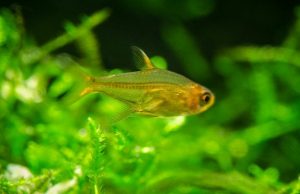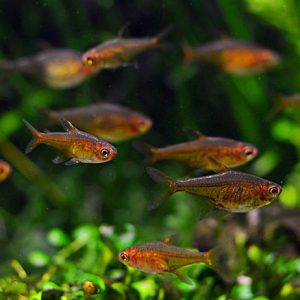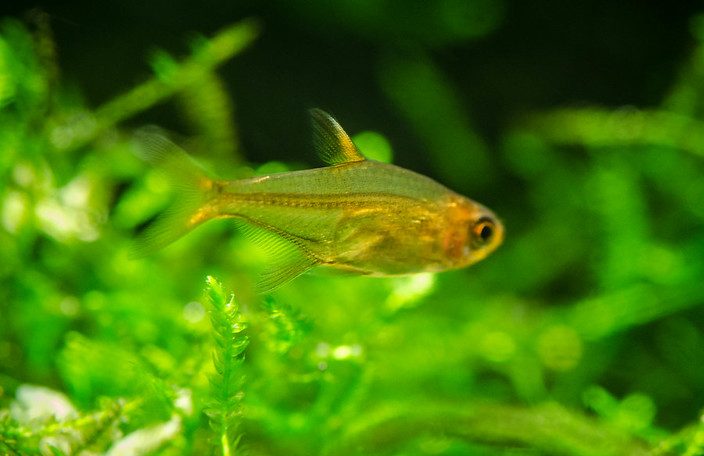The Ember Tetra is an eye-catching fish that will illuminate any aquarium and its temperament makes it a great choice for any community tank.
Tropical fish have become increasingly popular in recent years due to their striking appearance and playful personalities.
If you’re looking to join your aquatic family for truly unique fish don’t look any further. They are easy to look after in groups and they look wonderful.
They ‘re a great opportunity to get creative with your tank setup as well!
Overview
Sometimes referred to as the Fire Tetra, the Ember Tetra also known as Hyphessobrycon amandae is a small freshwater fish of the Characidae family, native to Central-West Brazil’s slow-flowing rivers.
They come from one of the most varied orders: Characiformes (which has nearly 2000 fish in 19 families). They are among the species with the most impressive appearance by far.
Ember Tetra is a newly described species that was first found in Central Brazil’s Mato Grosso State.
Because of their bright appearance, these fishes are very popular with fish keepers.
Even though classifying most fish in Characiformes is a challenging task, its bright, fiery appearance makes Ember Tetras easy to distinguish.
They ‘re an active and still very peaceful fish. When it comes to keeping they are not a demanding fish either, partly because of the size.
It doesn’t matter how much fishkeeping experience you have-they ‘re a great choice for anyone. They can live up to 2 years in a well-maintained tank.
The ember tetra (Hyphessobrycon amandae) is a Characiformes family’s freshwater fish (family Characidae).
It is native to the Brazilian Araguaia River Basin, discovered in 1987 and named in honor of the mother of fish explorer Heiko Bleher (Amanda Bleher).
This species is of typical tetra shape but grows to a maximum total length of approximately 2 cm (0.8 in.); most exhibit striking orange and reddish color with slight translucency near the pelvic fin.
The eye often mirrors the fish’s color and it is outlined in black.
The behavior of Ember tetra fish
Ember Tetra comes from a very wooded, green area. This plant abundance was a big influence on their behavior. In the wild, plants, logs and drifting wood generally serve as safe spots or breeding grounds.
Those species are not shy, in spite of their size.
They are in fact active swimmers, fast swimmers and quite playful. These types of fish can be found swimming or hiding within plants.
They ‘re also more likely to be found in the middle section of the tank (they rarely swim near the bottom).
Even though Ember Tetras are active and not easily frightened, it still takes some time for them to adapt to a new tank. You can expect fish to act strangely during that time or to be overly cautious.
They are happiest as shoaling fish when they are surrounded by other Ember Tetras. This also greatly reduces the time required to adapt. Not only that but in groups, they look even more amazing.
Their size is partly responsible for their peaceful and cautious behavior-imagine fish acting aggressively about 1 inch in length. That isn’t going to last long.
Appearance

How does an Ember tetra look with respect to its appearance? Here in this section, we will talk about the appearance of this fish. Thanks to their distinctive appearance, they are easily identifiable.
They are fiery red, sometimes with a gradient of saturated orange. Often eyes have an orange rim too. Ember Tetra is small and reaches approximately 0.8 inches long.
Their body shape is somewhat elongated, with the abdomen of females during the breeding period being slightly oblate. Compared to males, female fish also usually have a larger air bladder.
They have a fused anal end, a relatively small dorsal fin and a large caudal fin. Dorsal and caudal fins have a gradient which is slightly light grey or black.
Over the eyes and around the mouth the upper part of the head can sometimes be a reddish color.
Their body may seem slightly compressed backward-this allows them to move more smoothly around. Their scales are very compact, and they lie close to one another.
They look slightly transparent, because of this.
Habitat and Ideal conditions for tanks
Naturally, Ember Tetra is found in slow-flowing rivers, lakes and sometimes swamps. The areas in which these species are found are heavily surrounded by plants and trees, the majority of which end up on the riverbed. This provides shelter to many other fish and animals.
It may serve as food or breeding grounds, as well as shelter.
Soil is usually soft and dark on the riverbed, sometimes mixed with light rocks or gravel including sand. Rivers are generally quite shaded by plants and trees in those regions.
Tank condition
The proper tank condition for Ember Tetra is freshwater fish that prefer slow-flowing water to small rivers.
The preferred pH is in the 5.5–7 range and water hardness should not exceed 18dH. Water temperature should be kept within a range of 68–82 ° F.
Because they are found in heavily planted areas and “green” riverbeds, this needs to be recreated within the tank.
Examples of plants that you can keep with are Java moss, Java fern and Anacharis. The important thing to keep in mind here is to do everything in moderation-just place enough plants to hide fish and leave enough room for them to swim around.
In slow flowing tributaries, Ember Tetras are usually found quite distant from the main streams. That means you should try using a system of silent filtration and aeration.
Such a setup will create the required amount of movement of water while keeping it airy and not disturbing it. For this task, you may use a regular sponge filter.
There are no special requirements regarding the substratum but it is visually more impressive to have a dark one.
Another way to enhance your tank is by adding dry leaves; they leave a whole host of beneficial bacteria after they decompose.
Aquarium height depends on how many plants and/or decorations you wish to fit in. It’s nice to have all those decorations, but not unless you have to sacrifice free space in the tank for that.
You can experiment with the aquarium environment, only keep in mind the main points above.
Articles you might want to check out
Complete care Jack Dempsey fish: Care, lifespan, breeding and tank mates
Ember tetra Tank mates

Selecting right tank mates for your Ember Tetras is essential. They are peaceful and friendly fish in the community.
However, these fish look great in tanks for the community, and rarely cause trouble. They rarely pick food from the bottom of the tank, because they spend most of the time in the middle layer.
That makes pygmy catfish an excellent choice for a tank mate.
Other than that, fish which have a similar temperament and size are best kept. Small corydorae, for example, or other peaceful Characidae fish.
Fish that prefer to swim in a different layer of water also make good mates for the tank such
Here are few tank mates for your Ember tetra:
- Hatchet fish
- Dwarf cichlids
- Rasboras
- Micro rasboras
- Neons
Large, aggressive fish (especially predatory ones) should not keep them. Consider the same points if you decide to introduce any non-fish inhabitants into the tank.
Most shrimps and snails, as long as they do not destroy your plants, are fine to keep with those fish.
Ever wondered How electric eels produce electricity? Check out How do Electric eels work
Ember tetra Feeding
The natural feeding or diet of An Ember Tetra is mostly composed of small invertebrates and other zooplankton. Sometimes they can be found grazing on plants, scraping colonies of microbes that live there.
They can be feeding happily on dry foods, either flakes or granules. In addition to artificial feed, live or frozen foods (Aartemia, Daphnia, or Grindal worms) are recommended.
Try to make this as diverse as possible when it comes to putting together the diet. Ember Tetras’ feeding habits directly affect its appearance and color. Keep their size in mind too – grind up the food when necessary.
Small portions should be given two to three times a day.
Plants in your aquarium which can naturally graze on these fish are a great addition to their diet.
Healthy fish don’t need extra supplements. Holding a diverse diet is the best way to ensure your fish stay healthy. Being proactive and not reactive is the best way to feed your fish.
Caring your Ember tetra
The Ember Tetra is a small freshwater fish and like other freshwater fish, they are highly sensitive to changes in lighting or temperature and acidity in the water.
They are quite healthy species despite what their size may suggest and are not prone to any particular diseases.
Overfeeding is always a small-fish problem. Its digestive system can cause a lot of problems. If your fish acts oddly or looks exhausted-take a look at what they eat.
It may also be the quality of the food which affects your fish’s health. So, consider investing in slightly more expensive foods when you feel there is a problem with that.
Consistent renewal of water is crucial to their health, as is consistent with aeration and filtration.
This requires constant attention because the aquarium is so densely packed with plants. A tank full of algae or bacteria is not a very pleasant sight, so take time to regularly clean it out.
Even though it is more harmful to your aquarium’s overall look than it is to the fish, excessive algae can also cause inhabitants trouble.
It’s hard to look after all that’s going on in your tank and parasites sometimes manage to slip in. Parasitic diseases are generally expressed by bloating certain areas of the body or creamy dots on the skin.
In some cases, dysfunctional shoaling behavior can also signal parasite presence.
Breeding
Breeding the Ember Tetras isn’t a hard task. They are free spawning fish, meaning the parents don’t care about fry.
Spawning occurs frequently under well-monitored conditions and requires no intervention. However, this process should be controlled with a view to increasing the amount of fry.
You need a tiny frey tank. To optimize the acclimatization process both for fry and parental fish, water should be taken from your main aquarium. The lighting should be dimmed, and weak filtering of the water.
You can try to set the pH near neutral to stimulate spawning and keep the water temperature around 80-82 ° F.
Giving live fish food is recommended for 2 weeks before spawning. In order to prevent the parents from eating the fry, either places them in a separate tank or place a breeding mesh at the tank base.
Complete care on Firemouth cichlid
In the Aquarium
Ember tetras should be kept in acidic water with a pH close to 6.6 and although they have very soft water in their native habitat they have adapted quite well to a wide range of hardness (5–17 dGH).
The recommended temperature range is from 23 to 29 C (73 to 84 F). Ideally, their tank should contain live plants, a darker substratum and swimming open water.
To encourage schooling, Ember tetras should be kept in groups of at least 4–6.
They enjoy a heavily planted aquarium, ideally with a small area shaded by direct light and will spend a lot of time swimming through planted areas, which also provide some protection for their fry.
Ember tetras will be schooling with other tetras, such as the neon tetra, but the presence of significantly larger fish may become stressed.
These fish swim at the aquarium’s middle level and do not feed on the tank ‘s bottom.
It is therefore recommended that they are kept together with other bottom-dwelling fish (such as pygmy corydoras) so that the remaining food is then consumed off the substrate and not left to waste.
A variety of foods can be fed to Ember tetras, including flake, frozen, and freeze-dried foods. Also recommended are small live foods like worms and brine shrimps, as they bring out the colors of the fish.
Ember tetras have been known to live 10 years or more in a well maintained heavily planted aquarium.
Should you add Oscar fish
Conclusion
Should you keep Ember tetra in your Aquarium?
Are you looking for a nice, colorful and bright fish to join your community tank? If so the Ember Tetra will be perfect for you!
It has become one of the most popular tropical fish for community aquariums due to its bright colors and unique appearance.
The only thing to remember is their size and sensitivity to the parameters of the water. With big or aggressive fish Ember Tetras should definitely not be kept.
This fishes peaceful temperament allows them to fit easily into nearly any type of aquarium. It is also a great opportunity to try out a 10-gallon tank Nano set-up.
You may contact us here. We at Planet fish value your feedback and suggestions.


Избранные актуальные новости часового искусства – трендовые коллекции известных часовых марок.
Точно все варианты часов от недорогих до экстра дорогих.
https://watchco.ru/
Все свежие события мира часов – новые коллекции культовых часовых домов.
Абсолютно все коллекции хронографов от недорогих до супер роскошных.
https://bitwatch.ru/
Точно важные новинки модного мира.
Все события мировых подуимов.
Модные дома, бренды, высокая мода.
Новое место для стильныех хайпбистов.
https://sport.mskfirst.ru/msk/2024-04-20-chikunova-poluchila-travmu-vo-vremya-chempionata-rossii
Точно важные новости модного мира.
Абсолютно все эвенты известнейших подуимов.
Модные дома, торговые марки, гедонизм.
Лучшее место для стильныех хайпбистов.
https://ekbtoday.ru/news/2024-05-21-zhiteli-sverdlovskoy-oblasti-vystupayut-za-zashchitu-zelenyh-nasazhdeniy-v-gorodah-regiona/
Абсолютно свежие события подиума.
Все эвенты всемирных подуимов.
Модные дома, лейблы, haute couture.
Приятное место для модных хайпбистов.
https://msk.rftimes.ru/news/2024-05-03-nelegalnyy-migrant-razvratil-devochku-v-parke-moskvy
ссылка на интересную статью, рекомендую ознакомиться, перейти на сайт, на русском языке bajsfbrnbl … http://google.is/url?q=https://skopin-college.ru
Wonderful website. Lots of useful info here. I am sending it to some buddies ans additionally sharing in delicious. And naturally, thanks for your effort!
Модные заметки по подбору стильных видов на любой день.
Обзоры профессионалов, новости, все дропы и мероприятия.
https://luxe-moda.ru/chic/505-7-luchshih-sumok-guess-dlya-pokupki-v-2024-godu-stil-i-funktsionalnost/